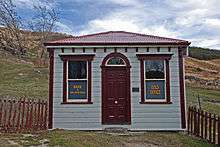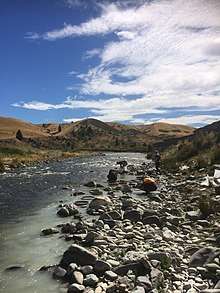Saint Bathans
The former gold and coal mining town of St Bathans, formerly named Dunstan Creek, lies deep in the heart of the Maniototo in New Zealand's Otago region. Mining has long ceased, and it is a tranquil holiday retreat. The preservation of many of its historic buildings makes it one of the region's more picturesque tourist venues. St Bathans is well known for its scenic man-made lake with beautiful looking clay cliffs that attract many tourists. It is currently a camping spot, and swimming is allowed in the lake.

The town was named for the Scottish Borders village of Abbey St Bathans by early surveyor John Turnbull Thomson; the Scottish village was the birthplace of Thomson's maternal grandfather. The area had previously been known as Dunstan Creek.[1] It is 40 kilometres northwest of Ranfurly and 60 kilometres northeast of Alexandra, near the Dunstan Creek, beneath the Saint Bathans Range and Dunstan mountains.
Prominent features include the historic Vulcan Hotel and the Blue Lake, a small lake formed during gold-sluicing, which gives it a distinctive turquoise colour. The area attracts many visitors intent on gold-prospecting.
- Road to Saint Bathans
- Blue Lake
- Post Office
- St. Patrick's Church
- Vulcan Hotel Billiards Room and Stables
Vulcan Hotel
The Vulcan Hotel (at 44°52′15″S 169°48′40″E) is a restored and reputedly haunted public house, located on the main street of St Bathans, and is the town's main tourist attraction. Originally called the Ballarat Hotel, it was built in 1882 of mud brick.[2] The building is registered as a Category I historic place by Heritage New Zealand.[3] The building is notable as possibly the country's most famous haunted building.[4] Room 1 of the hotel is reputedly home to the spirit of a young woman, thought by some to be a prostitute known "the Rose", who was strangled to death in the hotel in the 1880s.[5]
Geology and palaeontology

The town lends its name to the St Bathans fauna, a rich palaeontological section of the lower Bannockburn Formation of the Manuherikia Group, with an age range of 19–16 million years ago. The layer in which the fossils are found derives from littoral zone sediments deposited in a large shallow freshwater lake bordered by an extensive floodplains.[6] The fossiliferous layer has been exposed at places along the Manuherikia River close to the town, and is the remnant of the prehistoric Lake Manuherikia.
St Bathans mammal
In 2006, scientists reported the finding of nontherian mammal fossils in the Manuherikia Group near St Bathans. Previously it had been thought that bats were the only terrestrial mammals native to New Zealand. Dubbed the SB mammal (for St Bathans), the scientists' analysis indicates that the creature has a lineage distinct from monotremes (egg-laying mammals), eutherians (placental mammals) and metatherians (marsupials).[7]
Other taxa
The St Bathans formation also bears fossils of moa, mekosuchine crocodiles, turtles, skinks, tuatara, geckoes, at least eight taxa of waterfowl including the endemic Miotadorna and Manuherikia, a petrel, Accipitriformes, rails, a possible seagull, herons, a palaelodid flamingo, pigeons, parrots, a swift, an owlet-nightjar, songbirds, the enigmatic Aptornis and a primitive kiwi, Proapteryx.[8]
References
| Wikimedia Commons has media related to Saint Bathans. |
- Reed, A.W. (1975) Place names of New Zealand. Wellington: A.H. & A.W. Reed. p. 371
- The Encyclopaedia of New Zealand - The Vulcan Hotel
- "Saint Bathans". Register of Historic Places. Heritage New Zealand.
- TVNZ - One News - The Ghost of St Bathans
- New Zealand Ghosts - St Bathans Archived 2014-04-05 at the Wayback Machine
- Worthy TH; Tennyson AJD; Jones C; McNamara JA; Douglas BJ (2007). "Miocene waterfowl and other birds from central Otago, New Zealand" (PDF). Journal of Systematic Palaeontology. 5 (1): 1–39. doi:10.1017/S1477201906001957.
- Trevor H. Worthy; et al. (2006-12-19). "Miocene mammal reveals a Mesozoic ghost lineage on insular New Zealand, southwest Pacific". PNAS. Retrieved 2007-08-23.
- Worthy et al. 2013